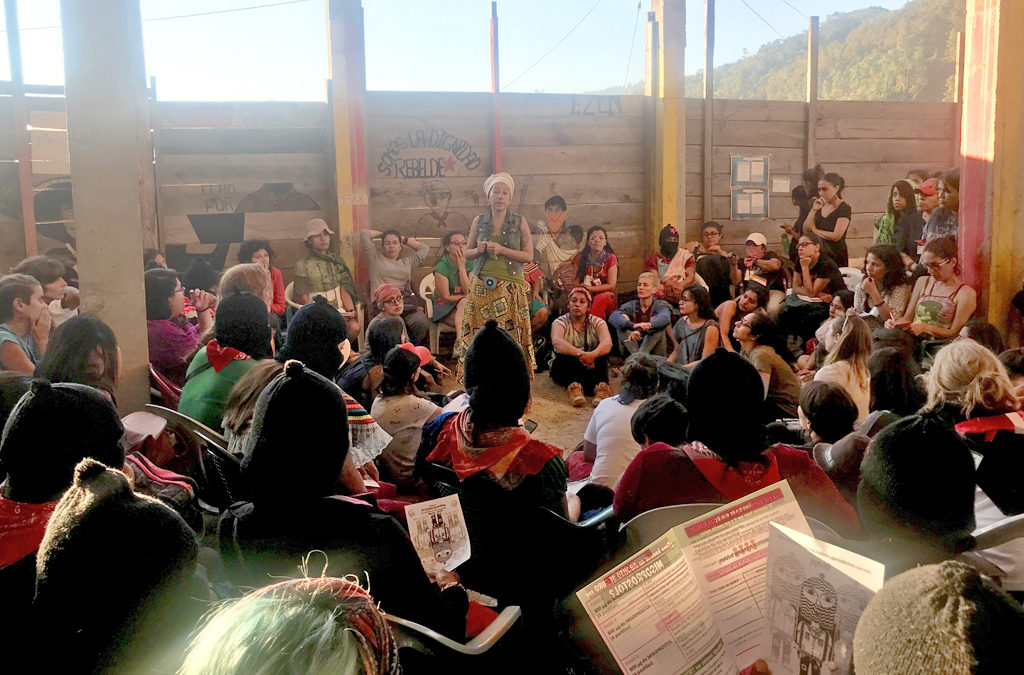Conventional approaches to feminist justice often focus on demands for equality between genders without abolishing the relation of domination that governs patriarchy itself. In patriarchal worlds, where humans categorized as male are granted rights over those categorized as non-male, feminist demands for equality often seek to prove that women can be equal to men by demonstrating an equal ability to dominate. Such approaches seek to “uplift” the oppressed position into the oppressor position, leaving patriarchy’s above/below structure of domination undisturbed. Other approaches, ones where women do not seek to be equal to men but rather seek their complete exclusion often preserve the relation of domination as well: they place women as superior (above) and men as inferior (below), flipping only the categories while leaving the structure of domination intact.
What would it look like to refuse to accept and reproduce patriarchy’s relation of domination? One of the most well-known examples of this exists in Chiapas, Mexico, where, as the Zapatista women put it, “We are equal because we are different.” In the Zapatista world, rather than beginning with the premise that one is equal once one meets a certain standard, equality is instead understood as a starting point. This means that Zapatista women do not demand sameness with men in order to be equal, and rather than organizing for women’s rights exclusively without men, theirs is instead a politics of walking juntos y a la par [together and side-by-side], as Sylvia Marcos details. They understand patriarchy as a structural, not simply individual challenge, placing it into the historical context of colonial plantation violence, which their communities lived through as serfs and slaves. They recognize that the political violence their grandparents suffered on the plantations they would tragically learn to replicate at home. Today, this means learning how to live otherwise. A famous example is the Zapatista Women’s Revolutionary Law, passed in 1993, which resists the imposition of various gender roles on women, encouraging their participation in government, capacitating them into the work even if it takes time. Increasing women’s participation can also mean capacitating men into domestic work to keep households flourishing while women are away, as well as recognizing that women can also reproduce patriarchy when they raise boys to be machos.
Thus, for Zapatista women, rights do not respond only to the needs of an individual woman. Within their Mesoamerican philosophical legacy, the individual and the collective are not mutually exclusive concepts; one does not subordinate the other. Similarly, the categories of male and female are fluid and complementary opposites, rather than binary and antagonistic. Their call is neither to dominate men nor to dominate like men. Instead, male, female, and gender-queer members of Zapatista communities collectively organize to abolish not the categories, but the relations of domination that govern patriarchy.
Further, the Zapatistas world is an example of a movement resisting far more than patriarchy. Indeed, those of us accompanying them by organizing in our own geographies, recognize that the above/below structure of domination is the governing logic of our shared oppressions. While it unfolds as a male/non-male binary under patriarchy, the above/below dualism is also the foundational logic of racialization (white/non-white), colonialism (Europe/non-Europe), the nation-state (citizen/non-citizen), capitalism (value/non-value), and the destruction of nature (human/non-human), one easily intersecting with another because they share a governing logic. While the structures of domination we struggle against are imposed and maintained through violence and the threat of violence, whether political or interpersonal, every day these structures are fueled and maintained by our own participation in them whenever we find ourselves in a below position and respond by seeking to go above, adding our weight to that which crushes others.
No doubt, a reason for this impulse is fear; we regularly witness the material consequences of being relegated to the below. Being there looks like rape, plunder, death, imprisonment, enslavement, deportation, landlessness, unemployability, contempt, lack of self-worth, and mere survivability, traumatizing us into believing that the only way we can live, survive, be free, and even experience love is by receiving acceptance into the above by the above. This acceptance can only be achieved by going above and crushing the below. And even when above, the fear of falling is a constant, stuck in the never-ending terror of falling down below, a possibility with each and every encounter with difference.
How might we better relate to difference? It’s a question worth asking more. Approaches to feminist justice, whether through calls for equality or exclusion, will leave patriarchy intact if they focus only on the categories shuffled into the above and the below, and not on the relation of domination itself. Moreover, such movements hinder men from joining anti-patriarchal struggles to liberate themselves from a system that also keeps them captive. As Black feminist theorist bell hooks was fond of pointing out, even if many didn’t like to hear, patriarchy is a violent process against males as well, for patriarchy demands that they engage in acts of psychic self-mutilation, killing off the emotional parts of themselves. Thus, without challenging patriarchy’s governing logic, the best such feminist approaches can do will be to continue legitimizing rather than dismantling domination, and therefore, reproducing further harm.
Linda Quiquivix is a popular educator of Maya roots who saves seeds, loves books, and makes art. She has a doctorate in geography and organizes in Chumash lands toward a world where many worlds fit.





